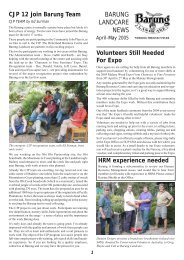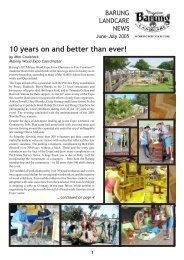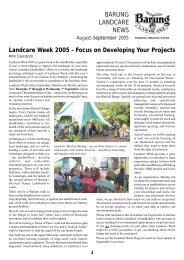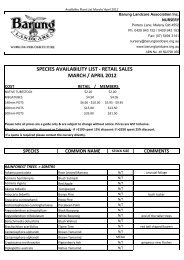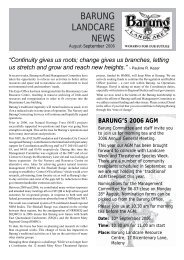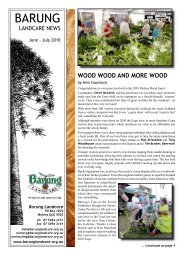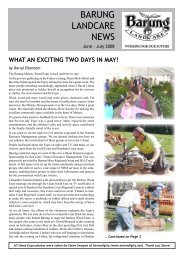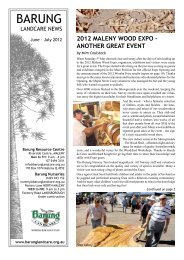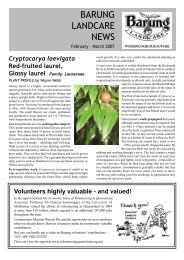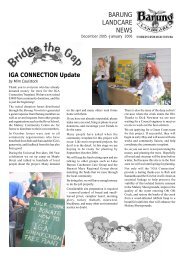Apr/May 2007 - Barung Landcare
Apr/May 2007 - Barung Landcare
Apr/May 2007 - Barung Landcare
Create successful ePaper yourself
Turn your PDF publications into a flip-book with our unique Google optimized e-Paper software.
Australian Landscapes:<br />
How they work, how to read them, how to fix them<br />
by Jonothan Waites<br />
Wouldn’t we all like to know? Peter Andrews, of Australian Story<br />
fame (or infamy!) and author of Back from the Brink, has been<br />
studying Australian landscape processes for more than 30 years.<br />
The result of his observations is a land management methodology<br />
he calls Natural Sequence Farming (NSF). NSF is based on<br />
Peter’s theory of how nutrients (carried by water) flow through<br />
and are recycled within our landscapes with the essential aid of<br />
vegetation.<br />
<strong>Barung</strong> <strong>Landcare</strong> recently supported Rosetta Books (as part of<br />
their author series of talks) in hosting an evening talk by Peter<br />
where he outlined his theory and some of its aspects to an interested<br />
audience in the Maleny Showgrounds Pavilion.<br />
NSF as a land management tool is a holistic (and therefore potentially<br />
ecological) approach to evolving landscapes to mimic the<br />
pre-European (or even pre-homo sapiens) valley floor feature<br />
known as the ‘swampy meadow – chain of ponds complex’.<br />
Through many years of keen observation, Peter has identified<br />
landscape functions and recognised the natural sequences which<br />
occur within them that enable ecosystems on this continent<br />
to endure. One such feature is landscape water storage. In the<br />
northern hemisphere water tends to be stored in large open water<br />
bodies. However in our dry, hot continent with high evaporation<br />
rates, water was stored successfully in the soil of the floodplain;<br />
Peter likens such floodplain storage to grass-covered dams.<br />
According to scientist John Williams (Founding member of the<br />
Wentworth Group of Concerned Scientists, Commissioner for<br />
Natural Resources for NSW), NSF is about how landscapes work,<br />
how to read them and how to put them back together again.<br />
Essentially, applying NSF techniques reconnects streams and<br />
rivers to the valley landscapes (catchments) through which they<br />
flow. This is important in terms of ecosystem function because it<br />
allows water (and the nutrients it transports) to be retained within a<br />
landscape for longer. This gives the plants growing there a longer<br />
period of access to these resources, ensuring them a better chance<br />
of reaching their greatest productive potential. The rate of water<br />
flow through a landscape is considerably slowed and its energy<br />
dissipated by the introduction of structures such as ‘leaky weirs’.<br />
These structures may consist of substantial engineering works<br />
(eg banks, barriers) or simple obstructions (eg rocks, sediments,<br />
trees, branches, leaves, grass).<br />
Valley floors are the fertility collection zone of a landscape. Valley<br />
floors which have a functional ‘chain of ponds’ floodplain system<br />
slow the movement of fertility through the landscape, facilitating<br />
the uptake of minerals and nutrients by plants which are then consumed<br />
by livestock, birds and bees. These animals then transfer<br />
that fertility to the top of the hills from whence water (aided by<br />
gravity) spreads it back down the slope (moving both above and<br />
below the ground). This is one of nature’s many cycles by which<br />
landscapes sustain themselves.<br />
An ideal farm layout, Peter believes, is one that is divided into<br />
thirds as follows; one-third forest and scrub (on the high ground<br />
– accumulating fertility under the trees), one-third agricultural<br />
(mid-slope – cropping, exploiting fertility) and one-third recovery<br />
area (valley floor – grass and weeds capturing fertility).<br />
Now these figures aren’t hard and fast, and the pattern could<br />
also be repeated several times on a slope, in a paddock or over a<br />
property. In a grazing situation it would be two-thirds grassland<br />
and one third forest area, with the forest area being selectively<br />
<br />
grazed (this, of course, depends on the purpose of the forest and<br />
other associated factors – not rainforest remnants please). Peter<br />
suggests that applying this method aimed at accumulating and<br />
retaining nutrients can result in the agricultural third being up to<br />
five times more productive. This is based on the supposition that<br />
pasture grass and crops extract fertility while weeds and trees<br />
add fertility to the land.<br />
A brief word about weeds. Many of the critics of NSF have made<br />
much of Peter’s use of weeds, particularly the dreaded willow.<br />
Peter doesn’t divide plants into natives and exotics, but rather<br />
assesses a species according to its function in the landscape. He<br />
regards many of our herbivorous weeds as great fertility accumulators<br />
which only occur in a landscape to correct a mineral<br />
deficiency or a particular soil condition. Willows, he contends,<br />
have functioned more successfully than natives would have where<br />
he has used them for the specific purposes he has had in mind.<br />
Focussing on one aspect, such as the use of weeds or a particular<br />
weed species, can distract us from the key principles of NSF, with<br />
the result that we miss the point.<br />
It is claimed that NSF properly applied can rectify a range of<br />
environmental problems such as salinity, erosion, eutrophication<br />
of waterways, and rising water tables. A CSIRO team was formed<br />
to evaluate the performance of NSF at Peter Andrew’s property<br />
‘Tarwyn Park’ in the Hunter Valley. Its report endorsed the general<br />
approach. In other words, ecologically NSF makes sense. Apart<br />
from the science, practical results speak for themselves. Photos<br />
of Peter’s property during the current drought show a body of<br />
green feed covering his valley floor, in stark contrast to the brown<br />
paddocks of neighbouring properties.<br />
The report also concluded that more monitoring and evaluation of<br />
NSF was needed in other areas along with its practical application<br />
in other landscapes.<br />
Funding available to trial NSF<br />
To this end, the regional body SEQ Catchments has obtained<br />
funding to set up some trials in this region. If you are interested<br />
in trialling NSF on your property, please contact me at <strong>Barung</strong><br />
<strong>Landcare</strong> or SEQ Catchments directly. It would be interesting<br />
to investigate NSF’s applicability to our landscapes with their<br />
predominance of first order streams and to determine just how<br />
the methodology might be practiced here. In an area such as ours<br />
with intensive agricultural land use, an increasing population and<br />
high rainfall (well usually), a management approach that enhances<br />
the retention of our increasing nutrient loads on the land and out<br />
of our streams deserves to be considered.<br />
This has been a necessarily brief overview of NSF; a simple<br />
system but a complex one to implement on a specific property<br />
or landscape. Only some of the environmental aspects have been<br />
touched on here, and there are also social and economic implications<br />
that need to be thought through. The <strong>Barung</strong> Library has a<br />
copy of Peter Andrews’s book Back from the Brink: How Australian<br />
landscapes can be saved available for loan to members as well<br />
as a double DVD, Natural Sequence Farming Workshop: Defining<br />
the science & the practice. There are also two websites:<br />
www.nsfarming.com and www.naturalsequencefarming.com.au<br />
I would encourage all readers (landholders in particular) to further<br />
explore NSF through these sources and consider how the principles<br />
might be applied to their own landscapes.



